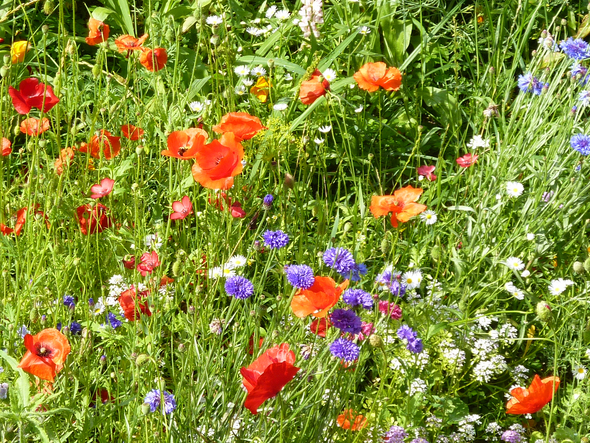A section of the grassed area surrounding the administration building has been turned into a real feast for the eyes: a colourful and diverse but purposeful meadow of wild flowers.
Preparation work started in April 2019. This included a lot of sand that was worked into the existing soil by the local garden centre as wild flowers need a poor soil. Then the wild flower seeds were sown.
Initially, the meadow just looked like a wild, unkempt patch of land and not flowery at all. One could only guess and hope that it would not just be weeds that grew here. Over the next few weeks, however, it soon became evident that the seeds had really started to germinate and that many small plants had taken root. Initially, it was the poppies and cornflowers that blossomed in varying colours. Week upon week the growth became luxuriant as these flowers were joined by marigolds, daisies, gypsophila, red flax, chamomile, snake head, bindweed, wild carrot, dill and many other plants. A variegated carpet of wild flowers spread around our administration building. And with the change of the season it always looks a little bit different, as new types of flowers are continuously emerging. Mallows, marigolds and asters are added to this in autumn, along with sunflowers that grow almost as tall as a person.
The wild meadow is bursting with life: Busy bumblebees hover around their patch and a variety of wild and domesticated bees dance eagerly from flower to flower, while swallowtails and red admirals flutter amongst them and tussle with the brimstone butterflies and painted ladies. If you watch the hustle and bustle that is concentrated in just one square meter of this wild flower meadow, you will be amazed at how diverse and lively it is. Here, the ecological cycle is continuously turning: It is not just the wide variety of insects and beetles that find a good source of food here, it is also the birds that eat the seeds and insects.
Once the meadow has blossomed, it is easy to care for and does not require much maintenance; as it only has to be cut once a year, preferably with a scythe or a scythe bar mower. The cuttings are left on the meadow for a few days so that the flowers will lose the last of their seeds. And the meadow should become even more variegated in subsequent years - we are quite excited to see what happens.
This biodiverse and amazing piece of ground even stops passing cyclists dead in their tracks as they standstill and gaze in wonder. One or two of them even capture this wildness of beauty on camera. And we get a great deal of support from visitors and colleagues for this approach to sustainability, which is particularly pleasing to receive.

